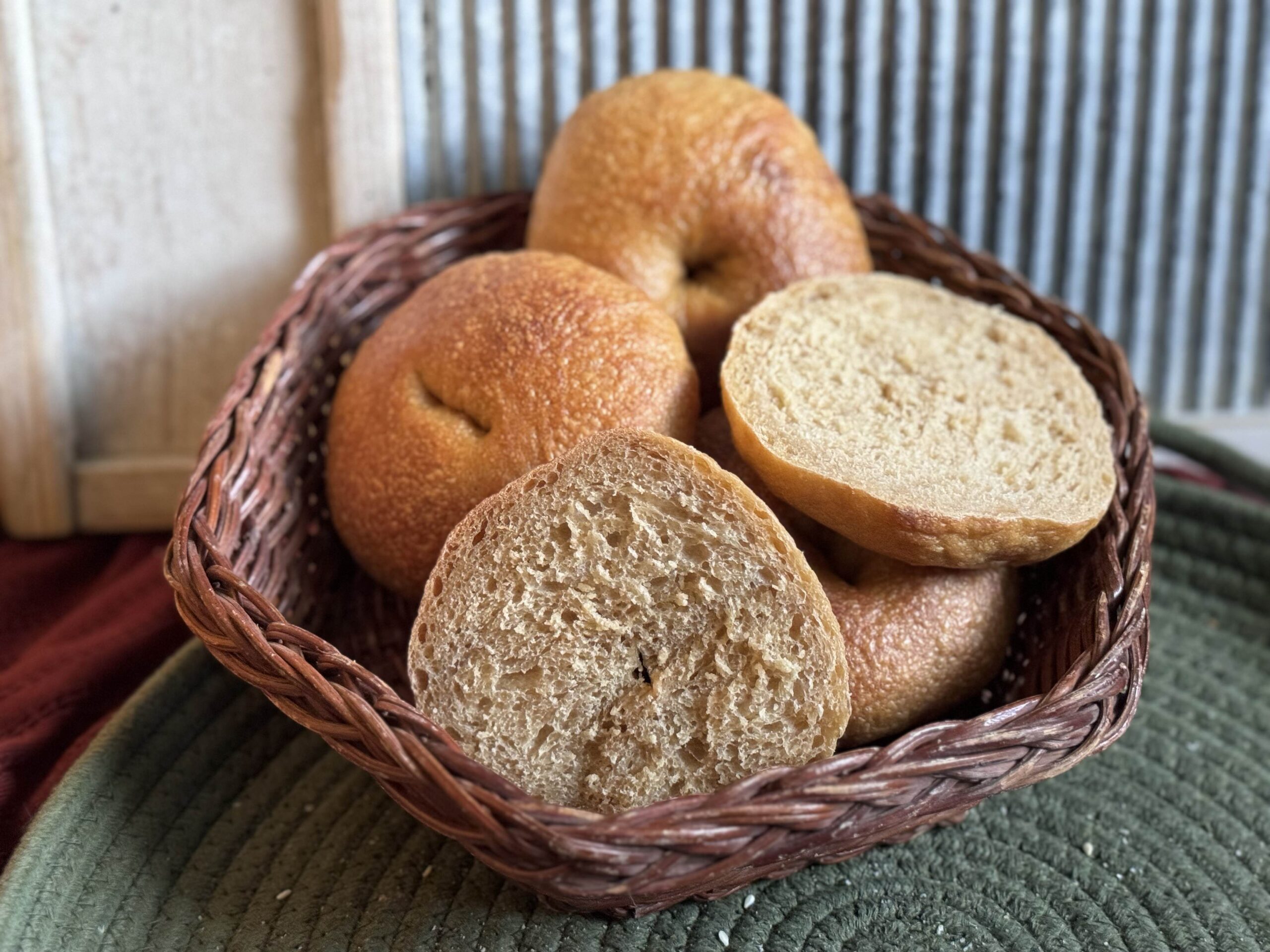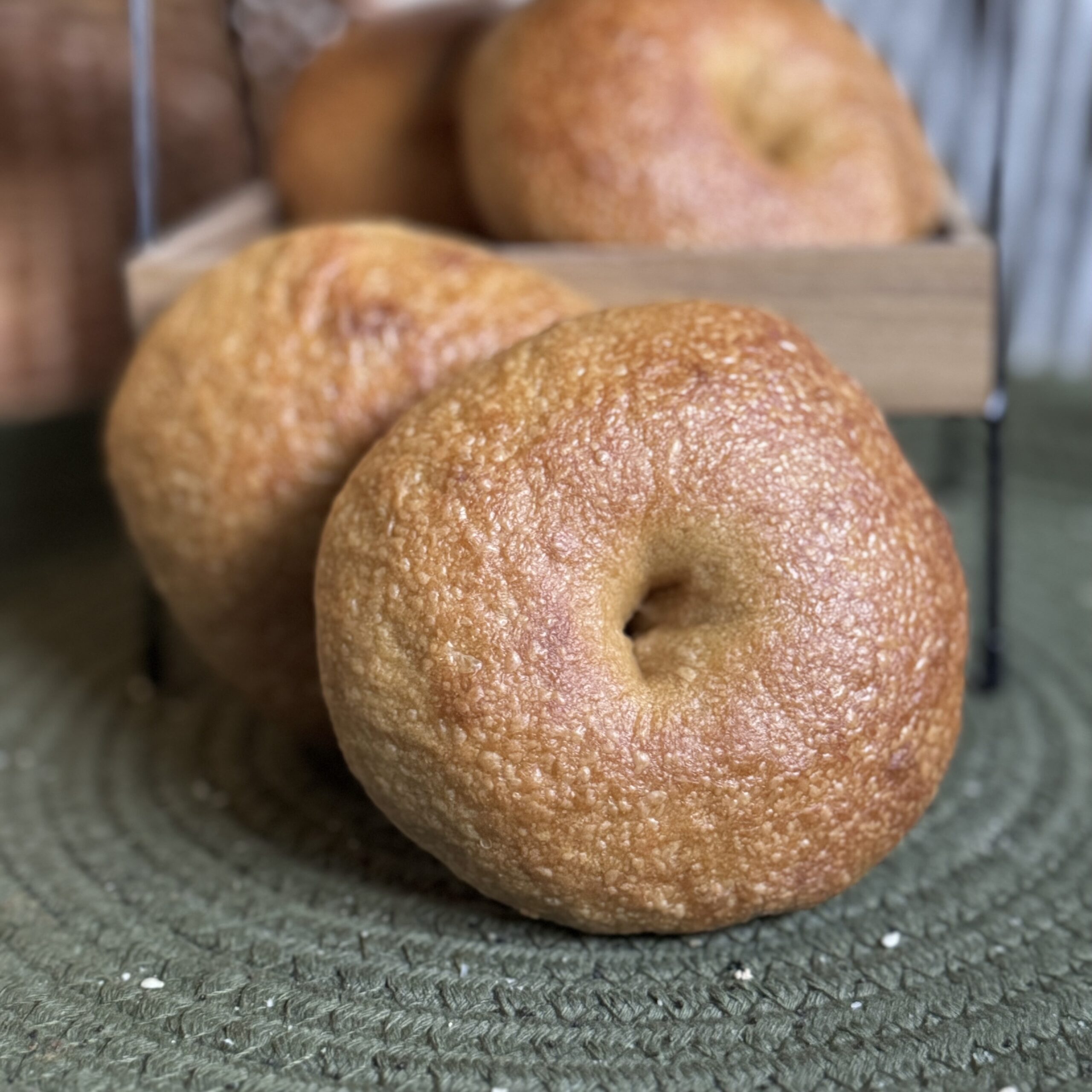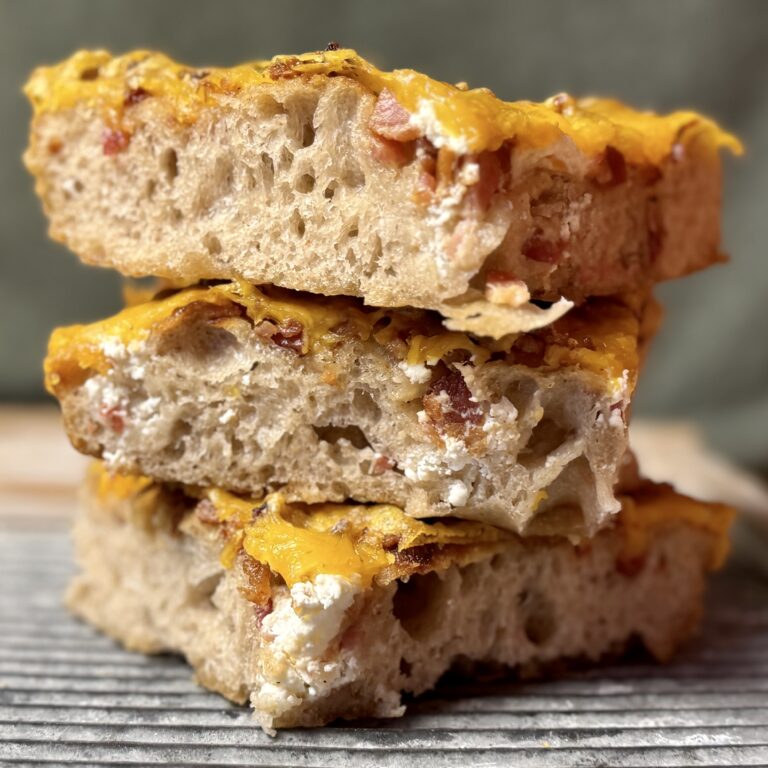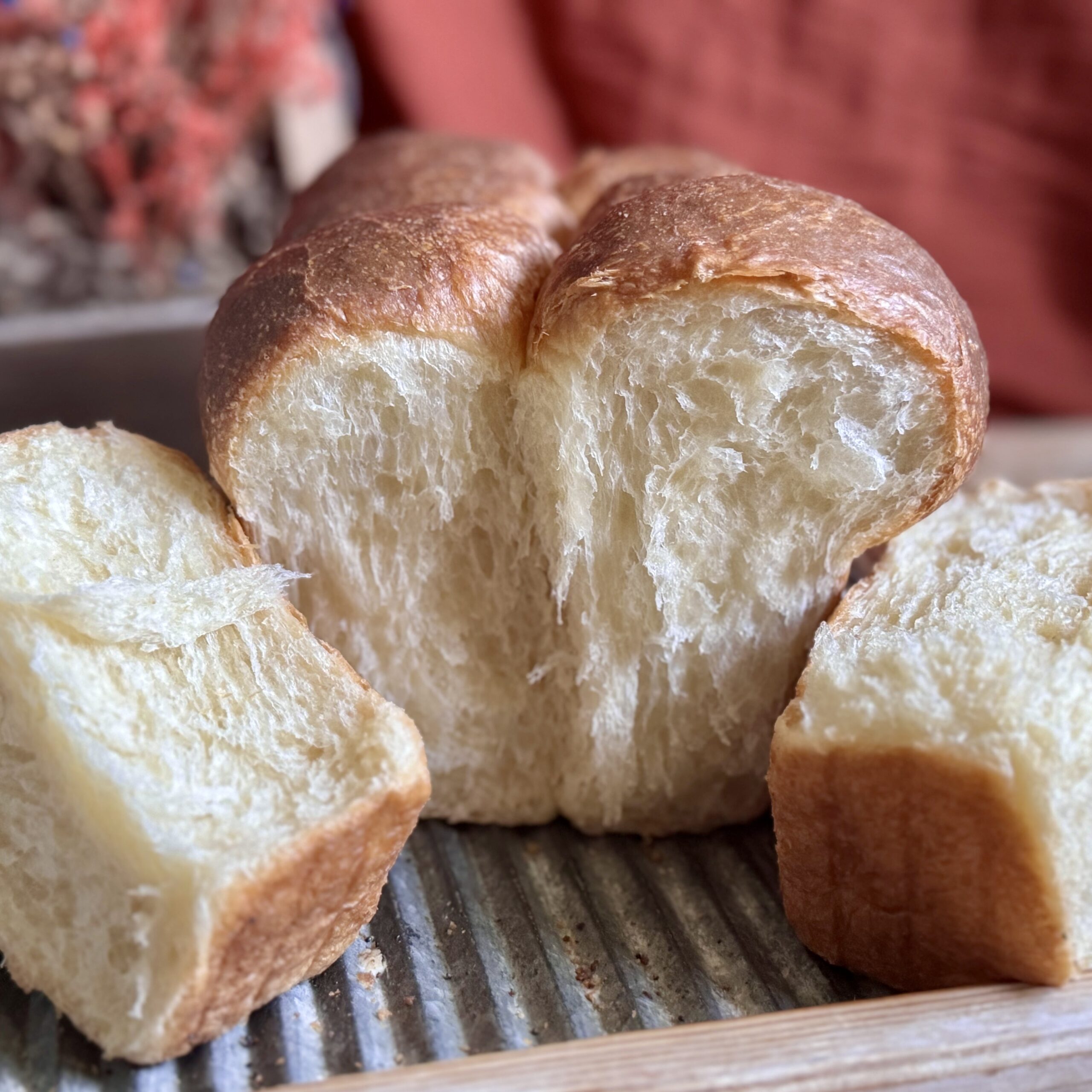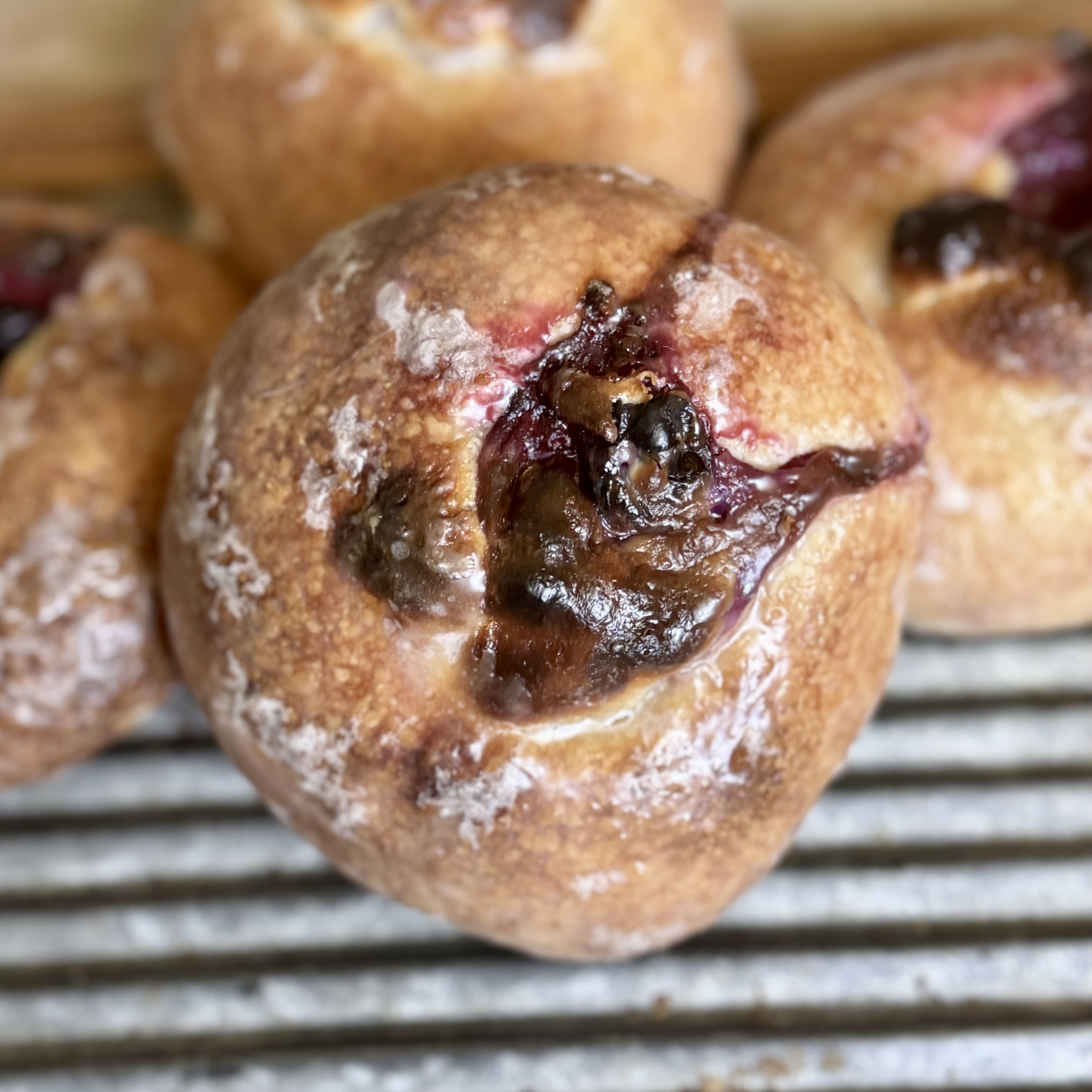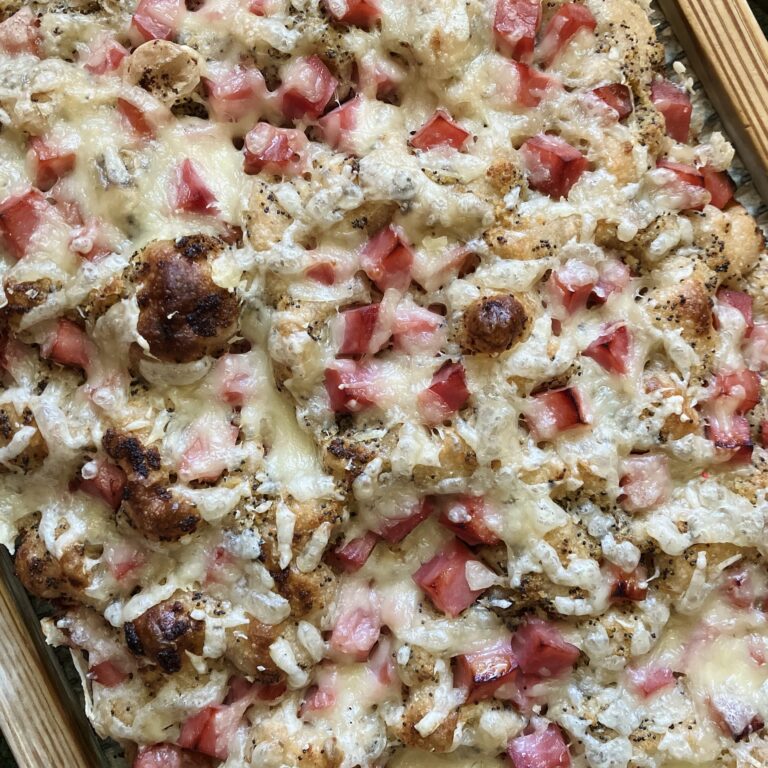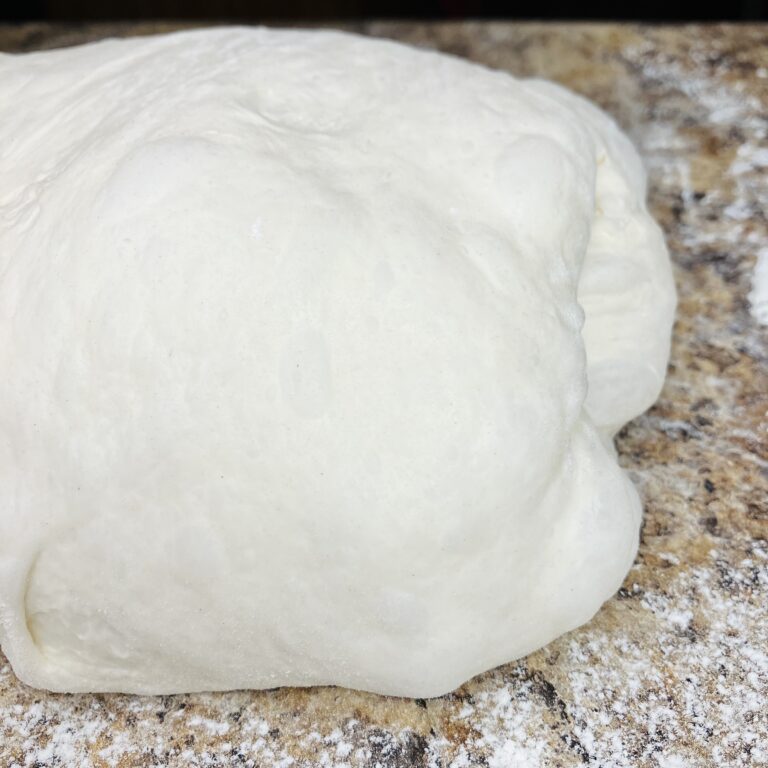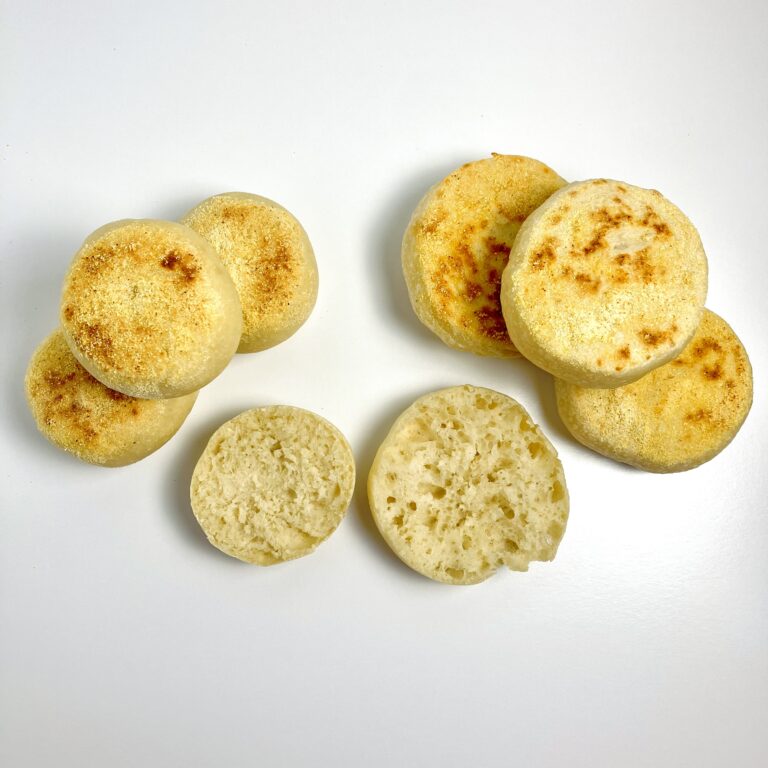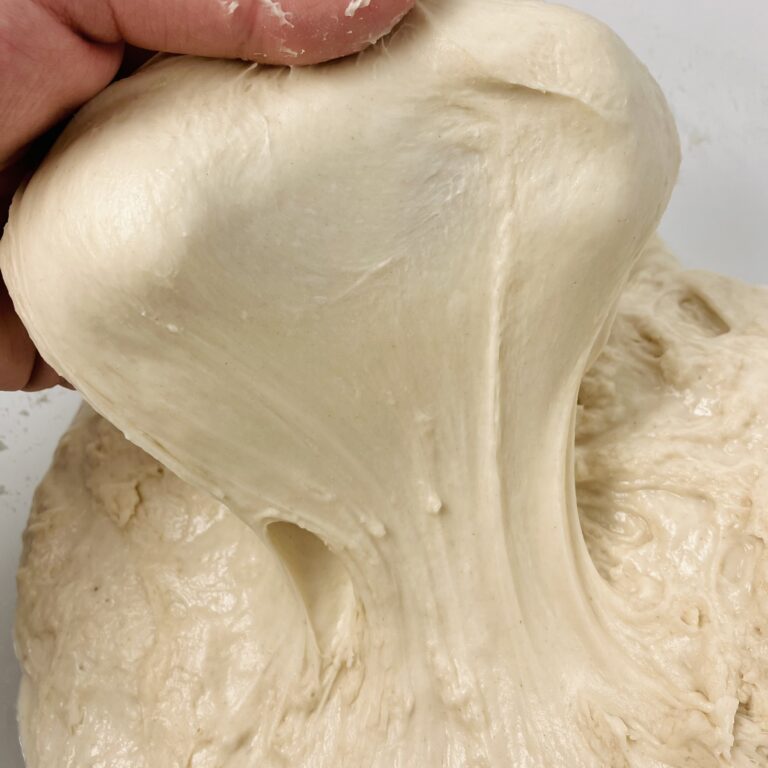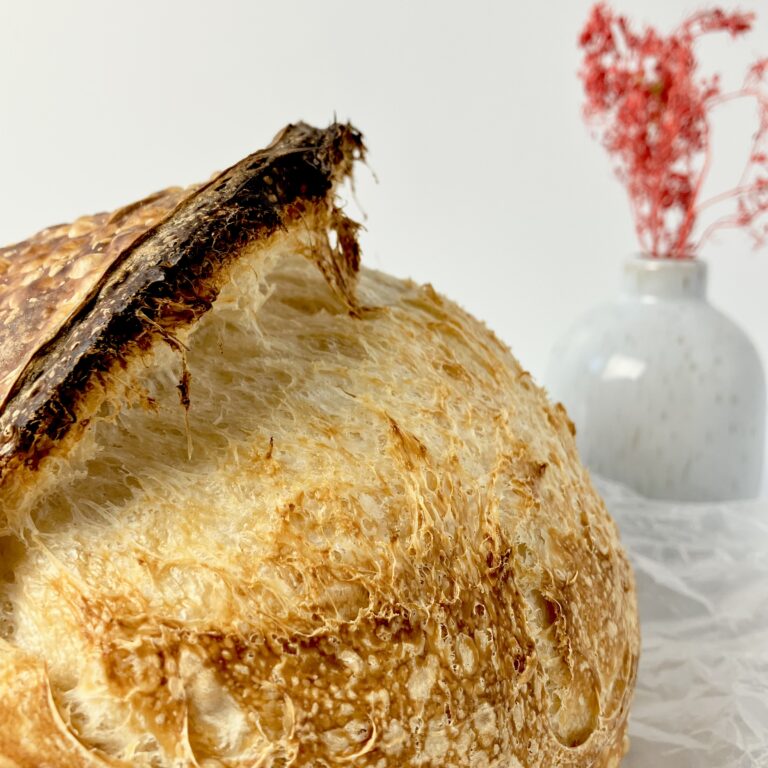About This Recipe
What is a bagel?
A bagel is a type of bread shaped like a ring, which has a dense, chewy interior and a slightly crisp, golden crust. The key to a bagel’s chewy texture and shiny crust is boiling before baking. This boiling step is a distinguishing feature of bagels, and sets them apart from other types of bread. After boiling, bagels can be topped with seeds (like sesame or poppy), dried minced onion, cinnamon sugar, or other ingredients before being baked. Bagels are often sliced horizontally and eaten with various spreads, such as cream cheese, or used as a base for sandwiches.
A brief history of bagels
Bagels originated in the Jewish communities of Poland in the 17th century, first mentioned in 1610 as a gift for women after childbirth. They likely evolved from the Polish bread obwarzanek and were named from the Yiddish word “beygl,” meaning “bracelet” or “ring.” Eastern European Jewish immigrants brought bagels to North America in the late 19th and early 20th centuries, where they became popular, particularly in New York City. The mass production of bagels began in the mid-20th century with the invention of automated bagel-making machines, making them widely available. Today, bagels are a global food staple, enjoyed with various toppings and fillings.
What I love about this recipe
This recipe lands the perfect combination of crispy and chewy. The crust gives a light, but present, crisp, while the interior of the bagel has a beautifully soft texture – every bite boasting a delightful chew. As always, I have taken consideration to each and every ingredient in the recipe and created an incredible balance. Even the addition of sugar in the dough is incredibly specific with a defined purpose (and it is not to sweeten). They can be topped with anything your heart desires and are the perfect companion to any breakfast or sandwich fillings.
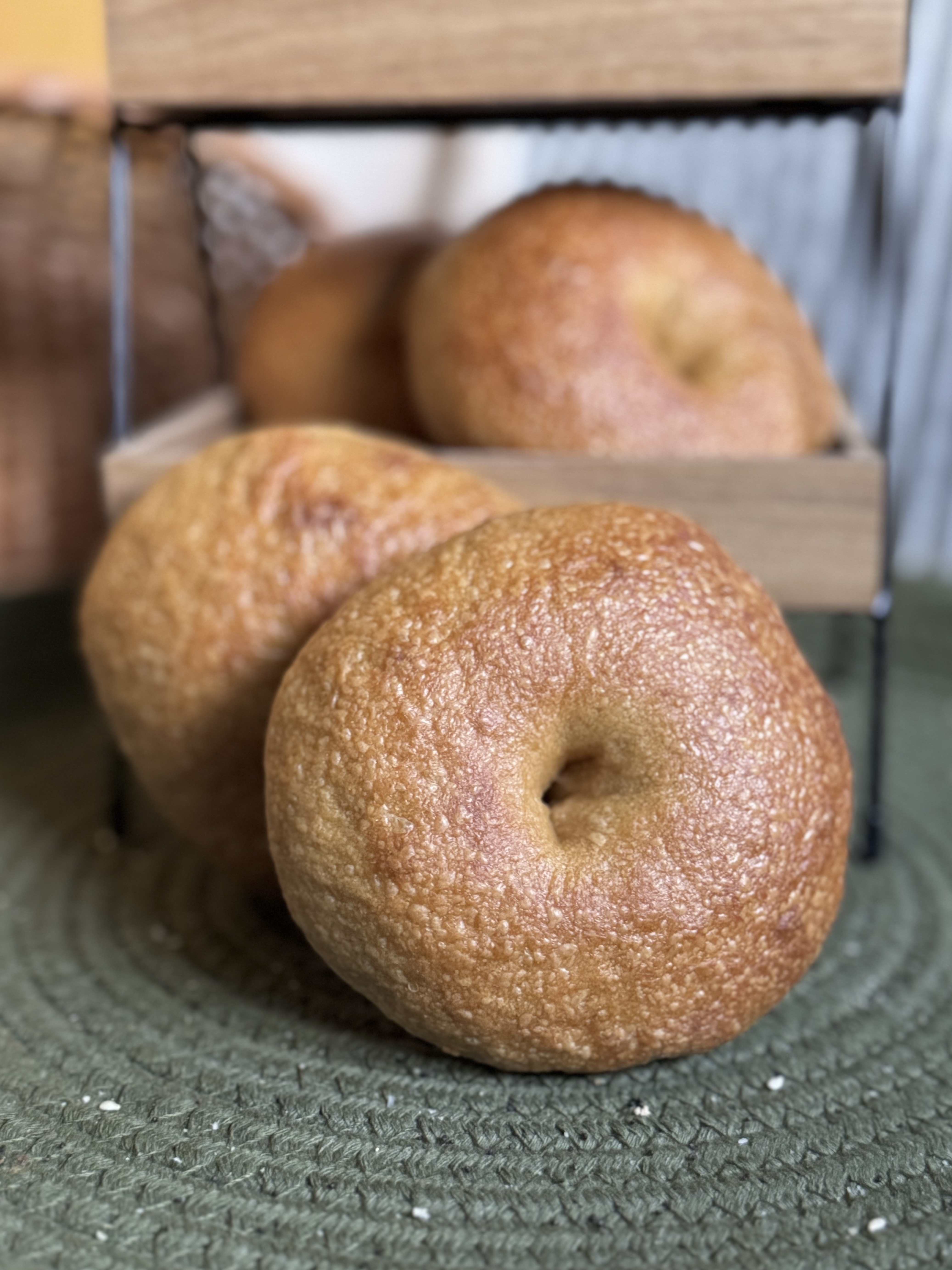

All the "why's"
Sweet Stiff Starter
Though this is not a sweet bread recipe, I chose to utilize a sweet stiff starter anyway. A sweet stiff starter works to reduce the overall sour flavor in sourdough bread products. The specific percentage of sugar (around 10-15%) creates what is called “osmotic stress,” which limits bacterial cell regeneration. Together with the additional flour in the starter, it is possible to virtually eliminate the sour flavor in a recipe, which is what I have done here. Read more about sweet stiff starter here.
Bread Flour
When working with stiff doughs like this one, gluten has a tougher time forming. This is because the decreased amount of water limits the mobility of gluten proteins, hindering the dough’s ability to form a strong network. Bread flour contains a higher percentage of protein, which aids in the bread’s ability to form gluten. I use King Arthur Bread Flour for its solid protein content, which is above 12%.
Barley Malt in the dough
In my trials, I found the actual type of sugar used does not matter, but chose barley malt because it is the classic sweetener many swear by for bagels. While the use of barley malt in a commercial yeast-leavened bagel is to aid in fermentation, the purpose in a sourdough bagel is a little different. The specific amount used in this recipe is around 10% of the total flour, which is the amount needed to create osmotic stress on the bacteria in your starter. This specific percentage, combined with the low hydration of the dough, works together with the sweet stiff starter to reduce the overall sour flavor of the bagel.
In essence, barley malt is not intended to add sweetness to the dough, but rather reduce the sour flavor. The end result is a mild, “normal” tasting bagel. The only time you should consider removing the barley malt is if you are intentionally going for a “sour” bagel. Other options/substitutions for the barley malt that yield the same effect include: white sugar, honey, and molasses. You could also try this recipe with maple syrup.
Vital Wheat Gluten
I usually recommend vital wheat gluten for flours that are low in gluten, as it helps build necessary strength in the dough. But, for this dough, I found vital wheat gluten to be incredibly helpful in creating a bagel that rises taller in the oven. Because this dough is low in hydration, it gives even the good bread flour an exceptional boost. If you do not own vital wheat gluten, you can skip it. But, I do think the use of it is well worth it in this recipe. See the image below for a visual comparison of a bagel made with vital wheat gluten versus the same recipe made without it.
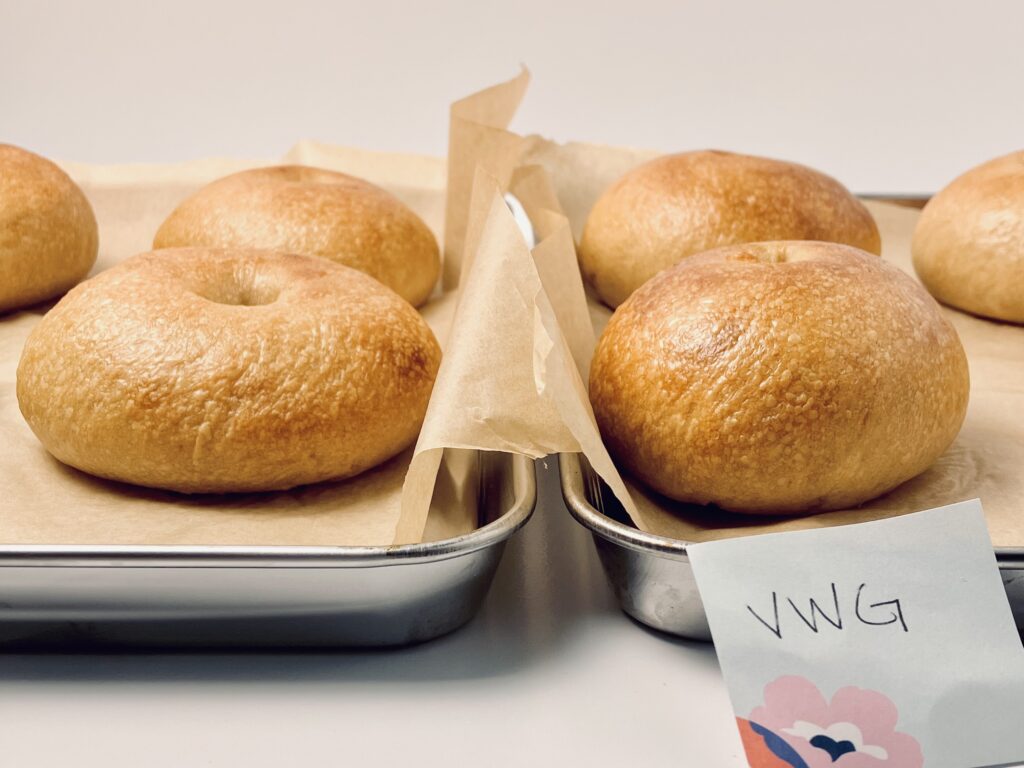
Low Hydration
Low hydration simply means “less water.” This is a stiff dough, and intentionally so. The stiff dough makes for a softer, denser bread. The “chew” of a bagel comes from the water bath, rather than the hydration itself, meaning that these bagels receive the perfect balance of soft crumb (from the low hydration) and chewy texture.
Gluten Development
Gluten can be easily developed in a stand mixer. Because of the low hydration, a low speed (speed two on a KitchenAid or three on an Ankarsrum) is all that is necessary, and the dough is ready to rise in ten to fifteen minutes. Alternatively, the dough can be turned out onto the counter and kneaded by hand for the same amount of time.
Flour choice and vital wheat gluten also work together to aid in the development of gluten. Be sure to consider these factors when making your dough.
Bulk fermentation
As always, bulk fermentation is flexible, with a few considerations. Because gluten can struggle to bind in a dough such as this one, the dough may appear to “overproof” faster. Though it is sometimes okay to let the dough rise beyond double in size, I would not recommend it for this recipe. If the dough rises too long, the bagels will not expand in the water bath, and may even shrivel up in the oven. Despite this, it is still desirable to push fermentation as long as possible. A stiff dough is dense, but a longer fermentation lends a softer crumb, ideal for a bagel. Though you could stop bulk fermentation at a 50% size increase, I recommend bulk fermenting the dough to double in size for best results.
Shaping
I use a pre-shape and a final shape for this recipe. The pre-shape gathers the sections of dough into a nice round, as well as tightens the outer skin so that it is smooth and even. After this is done, the gluten is tight, and needs a second to relax so that the dough can be stretched into a “ring” – the traditional bagel shape. The final shape does just this – it simply stretches the dough to the desired size of “ring” for that classic bagel look.
No Cold Proof
I found several recipes online that called for cold proofing bagels before boiling. Though I do this in my soft pretzel recipe, I did not find the results desirable in this bagel recipe. The bagels perform best and yield the most ideal flavor when they are left at room temperature to ferment. A cold dough will sink in the water bath, and may even stick to the bottom of your pot. The bagels may not expand properly and will be denser with an uglier final appearance. If you need to place your dough in the fridge to help with your baking timeline, do so just before or right after shaping. Then, let the bagels come to room temperature on the counter for at least one hour before boiling.
Water Bath
This step is essential to achieving the classic bagel chew. Bagels can be boiled anywhere from thirty seconds to two minutes per side – a longer boil creating a more pronounced chew in the bagel. I aim for forty seconds, but up to a minute, per side as my personal preference.
Barley Malt in the water bath
I include barley malt in the water bath, as I found it significantly improves the exterior color and shine on the finished bagel. It is not essential to include barley malt in the water bath for a good bagel, but makes for a noticeable improvement in the final look and even taste of the bagel. I tested honey as well, with the exact same results. Altogether, you can skip this addition if you prefer and still find yourself with a good bagel. Or, you can substitute the barley malt for honey, or even molasses, for similar results.
Baking Method
I tried several baking methods, including various temperatures and steaming methods. I found 425 F with no steam to be the perfect sweet spot. Because the bagels were boiled, there is plenty of moisture on the exterior of the bagel to help it expand properly in the oven, meaning it is not essential to add steam. 425 F gives a perfectly light crisp to the exterior, one that is not too pronounced or overbearing.
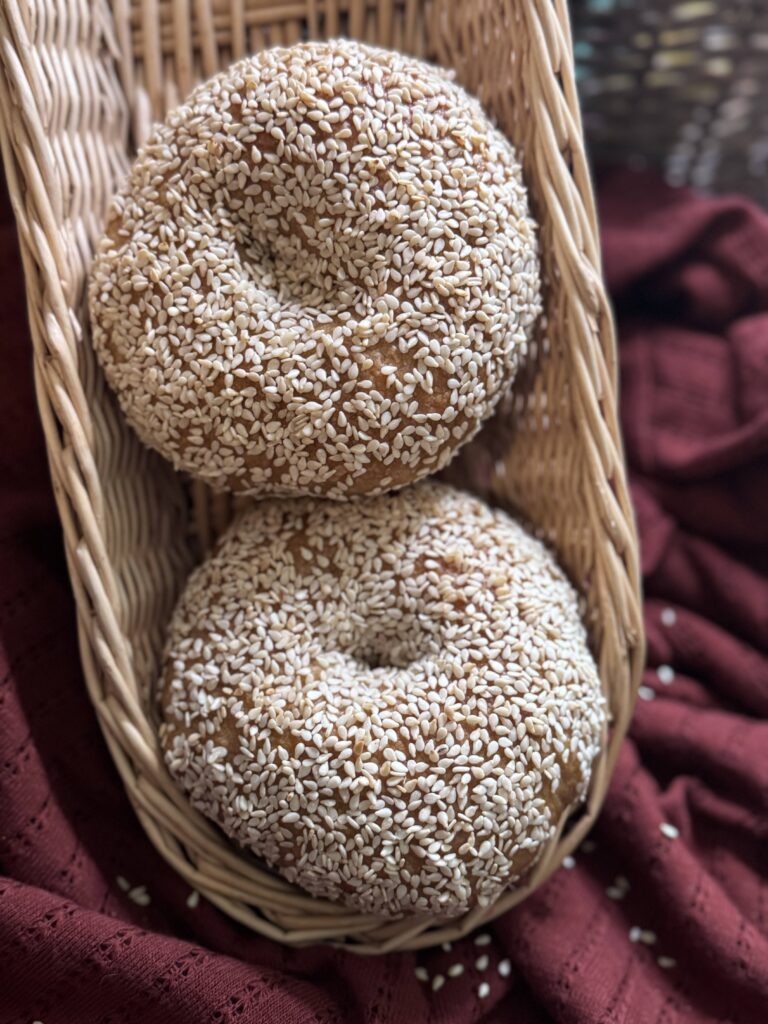
Suggested Daytime Baking Timeline
8 PM (Day 1)
+Make the sweet stiff starter.
7 AM (Day 2)
+Mix and knead the dough.
+Bulk rise to double in size.
3 PM (Day 2)
+Divide and pre-shape the dough.
3:15 PM (Day 2)
+Shape and proof the dough.
5 PM (Day 2)
+Boil and bake the bagels.
+Enjoy!
Suggested Overnight Baking Timeline
8 AM (Day 1)
+Make the sweet stiff starter.
9 PM (Day 1)
+Mix and knead the dough.
+Bulk rise to double in size.
7 AM (Day 2)
+Divide and pre-shape the dough.
7:15 AM (Day 2)
+Shape and proof the dough.
10-11 AM (Day 2)
+Boil and bake the bagels.
+Enjoy!

FAQS
Can I skip the sugar for a savory bagel?
The purpose of the sugar is not to make the recipe sweet; rather, it is to eliminate the “sour” flavor that comes with sourdough, giving these bagels a neutral, “normal” flavor. Unless you are seeking a “sour” bagel, do not skip the sugar.
Do I have to use barley malt in the dough?
No. You can replace the barley malt with an equal amount of white sugar, honey, or molasses for the exact same results.
I don't have Vital Wheat Gluten. is this necessary?
If you are a serious bread baker, or love and follow my recipes, I do recommend getting some for the cupboard, as it will most certainly be used. But, if you do not have it, you can skip it in this recipe. See the image above for the difference vital wheat gluten will make in the final, baked bagel.
What about the barley malt in the water bath? Is that necessary?
The barley malt in the water bath gives the bagels better color, shine, and increased flavor complexity. You can replace it with honey or molasses for similar results, or you can skip it altogether (the bagels will be just fine).
Bagels
Recipe by Caitlin VincentCourse: Breakfast, Lunch, SnackCuisine: Jewish, Polish, AmericanDifficulty: Intermediate20
minutes6-12
hours25
minutes8
bagelsIngredients
- Sweet Stiff Starter
40 g water (3 tbsp)
40 g active starter (3 tbsp)
80 g all-purpose flour (⅔ cup)
10 g white sugar (2 tbsp)
- Dough
300 g water (1 ¼ cup)
50 g barley malt syrup, honey, or molasses (¼ cup)
All of the sweet stiff starter
500 g bread flour (4 cups; I use King Arthur)
20 g vital wheat gluten (2 tbsp)
10 g salt (1 ½ tsp)
- Water Bath
4 qt pot filled about halfway with water, set over the stovetop to boil
¼ cup barley malt, honey, or molasses
- Optional
Toppings of choice: poppy seeds, sesame seeds, dried minced onion, cinnamon sugar
Directions
Make the sweet stiff starter. Mix together all ingredients for the sweet stiff starter 8-12 hours before you plan to make the dough. Knead for 2-3 minutes to incorporate, using lightly wet hands as needed. Cover and rest at room temperature.
Mix the dough. To the bowl of a stand mixer, add all ingredients for the dough. Roughly mix, then transfer to your stand mixer. Alternatively, this dough can be kneaded by hand.
Knead the dough.
- KitchenAid: Using the dough hook attachment, knead on a low speed (speed 2) for 10-15 minutes, until the dough is smooth and springs back when poked.
- Ankarsrum: Using the dough roller and scraper attachments, set the mixer to “ON” and let it run on speed 3 until the dough comes together. Adjust the roller so that it works the dough against the side of the bowl and use a spoon, as necessary, to help the dough along. After the dough comes together, set the timer for twelve minutes and let the Ankarsrum do its work.
- By hand: Turn the dough out onto a clean counter and use the “bench kneading” method to knead the dough for about 15 minutes.
Bulk ferment the dough. Remove the dough from your stand mixer and knead by hand for 1-2 minutes to form a smooth round. Transfer to a 2 qt bowl or proofing container. Cover with a lid or plastic cling wrap. Rest until the dough doubles in size (or completely fills the 2 qt container). This takes 8-10 hours at 70 F (21 C).
Divide and pre-shape. Divide the dough into eight sections, 125-130 g each. Pre-shape each section into a round by tucking all the ends underneath and pinching the seams on the bottom closed. Rest for 20 minutes. (This short rest gives the gluten a chance to relax so that it will stretch easier.)
Stretch/shape the bagels. Poke a hole into the center of each ball of dough, then rotate and stretch the dough until the hole in the center is the size of your liking. For bagels with pronounced holes, you’ll want to stretch the dough very far, so the hole is about four inches in diameter, and divide the bagels between two sheet pans. If the dough will not stretch as far as you like, let it rest, then try again in another 20 minutes.
Proof the dough. After the bagels are shaped, cover them and proof for 1-3 more hours, until they are very puffy and airy.
Prepare a work station. You’ll need a 4 qt pot filled halfway with water (set to boil on the stovetop), 1/4 cup of barley malt syrup, a skimmer, a wire rack over a baking sheet for draining, and possibly a new sheet pan for the boiled bagels.
Boil the bagels. To the boiling water, add ¼ cup of barley malt syrup. (You could also use honey or molasses.) Once the sugar is dissolved, add 2-3 bagels to the pot. If the bagels were proofed correctly, they should float immediately. Boil for 40-60 seconds per side, or up to two minutes for the chewiest bagels. Repeat for all the bagels.
Drain and top the bagels. Remove the bagels from the water bath and set over a wire rack to drain.
Bake the bagels. Transfer the bagels back onto a sheet pan and bake at 425 F (220 C) for 25 minutes.
Cool and enjoy! Transfer the bagels to a wire rack to cool for 15-20 minutes before slicing.
How to store: Bagels are best enjoyed fresh, but can be stored in a sealed bag on the counter for up to seven days, or sliced and stored in the freezer for several months.
To reheat: Slice and toast until warmed through.
Watch the Video
Notes
- I do not recommend a cold ferment for this dough. If you must, place the dough in the fridge when the dough hits about 75% size increase, or directly after shaping. Make sure the dough is at room temperature before boiling.
- For seeded bagels, brush with an egg white wash after boiling and coat with your favorite seeds. Bake as directed.
- For cheesy bagels, top with cheese after boiling. Bake as directed.
Join the email list
Join the email list to be notified when a new recipe or blog post comes out. No spam, just sourdough. Unsubscribe at any time.

